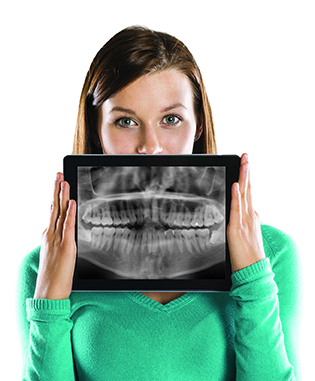

Digital technology has revolutionized the way in which we do many things, and the delivery of quality dental healthcare is no exception. As a seasoned dentist (how’s that for a subtle way of showing my age?!) I have witnessed first-hand the many ways in which computers have transformed the way in which dentistry is practised. One of the most profoundly positive impacts technology has had on dentistry is with the advent and progression of digital radiography. Patients benefit in many ways from digital or film-less x-rays and I am pleased that I can extend these benefits to my patients.
Lower levels of radiation
Digital radiation reduces a patient’s radiation exposure by usually up to 50 per cent compared to film-based x-ray systems. This is beneficial to dental patients and staff alike and complies with the ALARA principle – As Low As Reasonably Achievable.
Lessens need for retakes
During the process of developing film-based x-rays, things can and do go wrong from time to time. Overexposure for example, would necessitate a retake, thereby exposing a patient to additional radiation. Digital X-rays remove the risk of both human and mechanical error significantly.
No lost x-rays
Understandably, no patient wants to receive a phonecall that they have to come in for retakes because their x-rays have gone missing. As hard as anyone tries, mistakes happen. Tiny bits of film can fall out of charts. This problem is no longer an issue with digital x-rays which reside on a computer that is regularly and properly backed up.
Digital x-rays are “green”
X-ray processors require significant and ongoing amounts of chemicals in order to function properly, thereby generating high levels of chemical waste. The chemical requirements of digital radiography however, are zero. Plus, a paperless office means less energy is required and we lower our carbon footprint. That’s a big plus for our environment!
More accurate readings by your dentist
I love reading digital x-rays as I can see things much more vividly than I could in the past with a film-based imaging system. This is due to several factors…
- the maximum grayscale level of a film-based x-ray is 25 whereas a digital x-ray depicts 256 different shades of grey.
- I can manipulate x-ray images with a swipe on my tablet, reversing them, enlarging them, increasing the contrast and other little tricks to catch those tiny hidden cavities before they become problematic or to detect a well-concealed blocked root canal that one could have easily missed by looking at a film x-ray.
- Better patient communication and education
- Because digital x-ray images are so much easier to read due to the many ways in which they can be viewed and manipulated, I find that my patients also appreciate the opportunity of seeing what’s going on in their mouths for themselves.
Increased ease and efficiency of communication amongst practitioners
In the old days of film, if I needed to send one of my patient’s x-rays to a specialist, we’d have to locate the x-ray, duplicate it in our dark room and then rely on the mail or a courier to send over the copy. Now, it’s a drag-and-drop process. In under a minute, an x-ray can be emailed around the corner or around the world. This means faster courses of treatment for patients who can then go on with their lives pain-free.
Faster processing of insurance claims
Insurance companies often require patient x-rays in order to determine what they will and will not cover. Because digital x-ray transmission is so fast, we can help expedite insurance companies’ decision-making times and in doing so, get insurance funds into the hands of our patients faster.
Steven Deskin is a Brantford Dentist in general practice.


